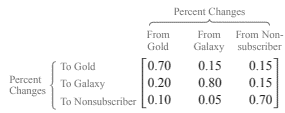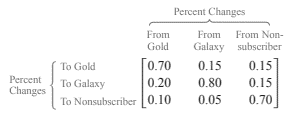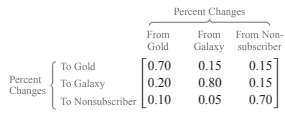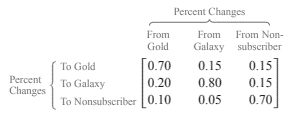
a.
Find the number of subscribers in one year for each company.
a.
Answer to Problem 5PS
The subscribers for the companies (in one year) are
To gold
To galaxy
To nonsubscriber
Explanation of Solution
Given:
The percent changes in satellite subscription each year matrix is given below.

The given subscribers for the companies are
To gold
To galaxy
To nonsubscriber
Calculation:
The current population in the three companies ( matrix form).
The percent changes matrix is
The populations in three companies in one year
Hence in one year, the subscribers for the companies are
To gold
To galaxy
To nonsubscriber
b.
Find the number of subscribers in two year for each company.
b.
Answer to Problem 5PS
The subscribers for the companies (in two years) are
To gold
To galaxy
To nonsubscriber
Explanation of Solution
Given:
The percent changes in satellite subscription each year matrix is given below.

The given subscribers for the companies are
To gold
To galaxy
To nonsubscriber
Calculation:
The current population in the three companies ( matrix form).
The percent changes matrix is
The populations in three companies in two year
Hence in two year, the subscribers for the companies are
To gold
To galaxy
To nonsubscriber
c.
Find the number of subscribers in two year for each company.
c.
Answer to Problem 5PS
The subscribers for the companies (in three years) are
To gold
To galaxy
To nonsubscriber
Explanation of Solution
Given:
The percent changes in satellite subscription each year matrix is given below.

The given subscribers for the companies are
To gold
To galaxy
To nonsubscriber
Calculation:
The current population in the three companies ( matrix form).
The percent changes matrix is
The populations in three companies in three years
Hence in three years, the subscribers for the companies are
To gold
To galaxy
To nonsubscriber
d.
Explain the (subscriber and nonsubscriber) the results of one to three years.
d.
Answer to Problem 5PS
The subscribers of the companies gold and galaxy are increasing and the number of nonsubscribers are decreasing.
Explanation of Solution
Given:
The percent changes in satellite subscription each year matrix is given below.

The given subscribers for the companies are
To gold
To galaxy
To nonsubscriber
Calculation:
The current population in the three companies ( matrix form).
The percent changes matrix is
The subscribers for the companies (in one year) are
To gold
To galaxy
To nonsubscriber
The subscribers for the companies (in two years) are
To gold
To galaxy
To nonsubscriber
The subscribers for the companies (in three years) are
To gold
To galaxy
To nonsubscriber
From the above results, the subscribers of the companies gold and galaxy are increasing and the number of nonsubscribers are decreasing.
Chapter 8 Solutions
Precalculus with Limits
- Find an equation of the curve that passes through the point (0, 1) and whose slope at (x, y) is 3xy.arrow_forwardQ6. A fossil piece has been found in Alberta that contains 34% of C14 in it. What is the age of this fossil piece?arrow_forwardQ5. Briefly explain what are isotopes of an elements, with an example, and why some isotopes are radioactive. 470arrow_forward
- Q1. Will you earn more interest amount in two years by depositing $2000 in a simple interest account that pays 6% or in an account that pays 6.15% interest compounded monthly? tarrow_forwardQ4. We want to invest $18000 in an account compounded continuously. How long should the investment be kept so final value of the account reaches $25000 if the annual rate of interest is 5.8%?arrow_forwardQ3. Determine the effective annual yield for each investment below. Then select the better investment. Assume 365 days in a year. a) 5.6% compounded semiannually; b) 5.4% compounded daily.arrow_forward
- Q2. You deposit $22,000 in an account that pays 4.8% interest compounded monthly. a. Find the future value after six years. & b b. Determine the effective annual yield of this account.arrow_forward18. Using the method of variation of parameter, a particular solution to y′′ + 16y = 4 sec(4t) isyp(t) = u1(t) cos(4t) + u2(t) sin(4t). Then u2(t) is equal toA. 1 B. t C. ln | sin 4t| D. ln | cos 4t| E. sec(4t)arrow_forwardQuestion 4. Suppose you need to know an equation of the tangent plane to a surface S at the point P(2, 1, 3). You don't have an equation for S but you know that the curves r1(t) = (2 + 3t, 1 — t², 3 − 4t + t²) r2(u) = (1 + u², 2u³ − 1, 2u + 1) both lie on S. (a) Check that both r₁ and r2 pass through the point P. 1 (b) Give the expression of the 074 in two ways Ət ⚫ in terms of 32 and 33 using the chain rule მყ ⚫ in terms of t using the expression of z(t) in the curve r1 (c) Similarly, give the expression of the 22 in two ways Əz ди ⚫ in terms of oz and oz using the chain rule Əz მყ • in terms of u using the expression of z(u) in the curve r2 (d) Deduce the partial derivative 32 and 33 at the point P and the equation of მე მყ the tangent planearrow_forward
 Calculus: Early TranscendentalsCalculusISBN:9781285741550Author:James StewartPublisher:Cengage Learning
Calculus: Early TranscendentalsCalculusISBN:9781285741550Author:James StewartPublisher:Cengage Learning Thomas' Calculus (14th Edition)CalculusISBN:9780134438986Author:Joel R. Hass, Christopher E. Heil, Maurice D. WeirPublisher:PEARSON
Thomas' Calculus (14th Edition)CalculusISBN:9780134438986Author:Joel R. Hass, Christopher E. Heil, Maurice D. WeirPublisher:PEARSON Calculus: Early Transcendentals (3rd Edition)CalculusISBN:9780134763644Author:William L. Briggs, Lyle Cochran, Bernard Gillett, Eric SchulzPublisher:PEARSON
Calculus: Early Transcendentals (3rd Edition)CalculusISBN:9780134763644Author:William L. Briggs, Lyle Cochran, Bernard Gillett, Eric SchulzPublisher:PEARSON Calculus: Early TranscendentalsCalculusISBN:9781319050740Author:Jon Rogawski, Colin Adams, Robert FranzosaPublisher:W. H. Freeman
Calculus: Early TranscendentalsCalculusISBN:9781319050740Author:Jon Rogawski, Colin Adams, Robert FranzosaPublisher:W. H. Freeman
 Calculus: Early Transcendental FunctionsCalculusISBN:9781337552516Author:Ron Larson, Bruce H. EdwardsPublisher:Cengage Learning
Calculus: Early Transcendental FunctionsCalculusISBN:9781337552516Author:Ron Larson, Bruce H. EdwardsPublisher:Cengage Learning





